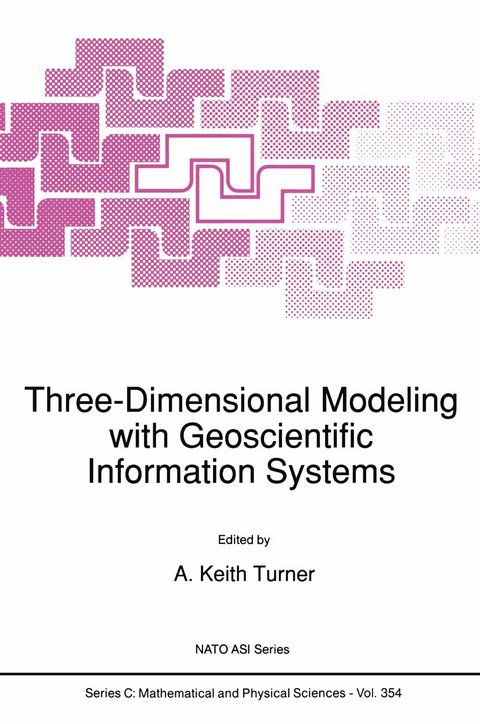
Three-Dimensional Modeling with Geoscientific Information Systems
Springer (Verlag)
978-94-010-5128-6 (ISBN)
A. K. TURNER Department of Geology and Geological Engineering Colorado School of Mines Golden, Colorado 80401 USA Geology deals with three-dimensional data. Geoscientists are concerned with three dimensional spatial observations, measurements, and explanations of a great variety of phenomena. The representation of three-dimensional data has always been a problem. Prior to computers, graphical displays involved specialized maps, cross-sections, fence diagrams, and geometrical constructions such as stereonets. All were designed to portray three-dimensional relationships on two-dimensional paper products, and all were time consuming to develop. Until recently, computers were of little assistance to three-dimensional data handling and representation problems. Memory was too expensive to handle the huge amounts of data required by three-dimensional assessments; computational speeds were too slow to perform the necessary calculations within a reasonable time; and graphical displays had too Iowa resolution or were much too expensive to produce useful visualizations. Much experience was gained with two-dimensional geographic information systems (GIS), which were applied to many land-use management and resource assessment problems. The two-dimensional GIS field matured rapidly in the late 1980's and became widely accepted. The advent of the modern computer workstation, with its enhanced memory and graphical capabilities at ever more affordable prices, has largely overcome these earlier constraints.
A: Preface and Achievements of the Workshop.- 1. Preface.- 2. Achievements of the Workshop.- B: Definition of the Problem.- 3. Spatial data handling in the geosciences.- 4. 3-D modelling with geoscientific information systems: The problem.- 5. Geologic data handling.- 6. The role of the conceptual datamodel in software application integration.- C: Existing Three-Dimensional Geoscientific Information Systems.- 7. A spatial information system with advanced modeling capabilities.- 8. The DASDBS geokernal - an extensible database system for GIS.- 9. Three-dimensional solid modeling of geo-objects using non-uniform rational B-splines (NURBS).- 10. A mapping approach to three-dimensional modeling.- 11. GOCAD: a computer aided design program for geological applications.- D: Three-Dimensional Data Structures and Display Methods.- 12. Modeling natural objects via octrees.- 13. 3-D structures for the encoding of geometry and internal properties.- 14. Methods for the efficient storage of spatial geologic data.- 15. Key 3D modelling concepts for geoscientific analysis.- 16. Geometry for three-dimensional GIS in geoscientific applications.- 17. GIDBS: a database system for hierarchically represented gray-scale images.- E: Applications of Three-Dimensional Geoscientific Modeling.- 18. Applications of 3-D geoscientific modeling for hydrocarbon exploration.- 19. Two major problems in representing geological well data and seismic data in petroleum-bearing regions via 3-D geographic information systems.- 20. The application of new 3-D computer modelling techniques to mining.- 21. Applications of three-dimensional geoscientific mapping and modeling systems to hydrogeological studies.- F: Transcriptions of Conference Committee Discussions.- 22. Report of discussions by the computer scientists.- 23. Report of discussions by the geoscientists.- 24. Report of discussions by the members of national geological surveys.- 25. Report of discussions by the hydrocarbon interest group.- 26. Report of discussions by the minerals exploration interest group.- 27. Report of discussions by the environmental sciences interest group.- 28. Report of closing discussions.- Glossary of Terms.- Survey of Participants.- List of Participants.
| Reihe/Serie | NATO Science Series C ; 354 |
|---|---|
| Zusatzinfo | XX, 443 p. |
| Verlagsort | Dordrecht |
| Sprache | englisch |
| Maße | 160 x 240 mm |
| Themenwelt | Mathematik / Informatik ► Informatik ► Theorie / Studium |
| Naturwissenschaften ► Geowissenschaften ► Geologie | |
| Naturwissenschaften ► Geowissenschaften ► Geophysik | |
| ISBN-10 | 94-010-5128-3 / 9401051283 |
| ISBN-13 | 978-94-010-5128-6 / 9789401051286 |
| Zustand | Neuware |
| Informationen gemäß Produktsicherheitsverordnung (GPSR) | |
| Haben Sie eine Frage zum Produkt? |
aus dem Bereich


